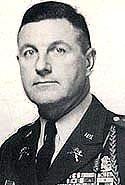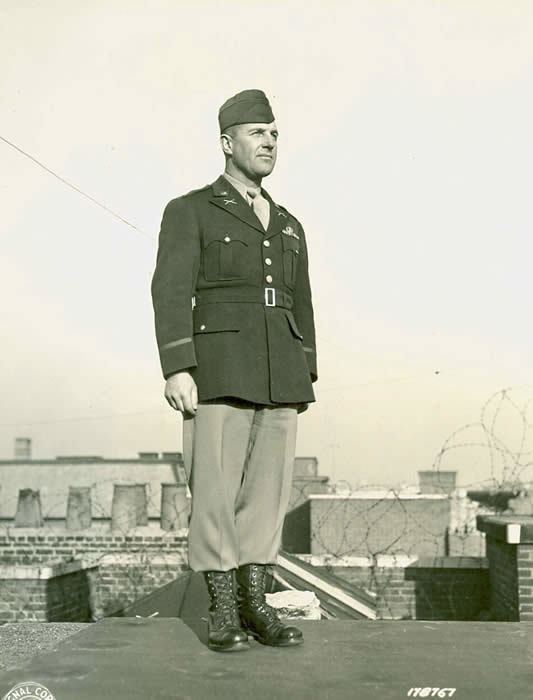Allegiance United States | Name Edson Raff Unit 509th Infantry Regiment Died March 11, 2003 | |
 | ||
Born November 15, 1907 ( 1907-11-15 ) Commands held 2nd Battalion, 509th Parachute Infantry Regiment, 507th Parachute Infantry Regiment, 77th Special Forces Group Battles and wars World War II, Operation Torch, Operation Overlord, Operation Varsity | ||
Colonel Edson Duncan Raff (November 15, 1907 – March 11, 2003) was a United States Army officer and author of a book on paratroopers. He served as Commanding Officer (CO) of the first American paratroop unit to jump into combat, the 2nd Battalion, 509th Parachute Infantry Regiment, near Oran as part of Operation Torch during World War II. His book, We Jumped to Fight, was based on his experience in that operation and was published in 1944.
Contents

Early life and military career
Raff had served as First Captain of Cadets at a small prep school in Winchester, Virginia called the Shenandoah Valley Academy before serving in the army.
He graduated from the United States Military Academy (USMA) in 1933 as a second lieutenant into the Infantry Branch of the United States Army.
World War II
By the time the United States entered World War II in December 1941, Raff had transferred to the army's fledgling airborne forces. Serving as Commanding Officer (CO) of the 2nd Battalion, 503rd Parachute Infantry Regiment, a paratrooper unit, commanded by Colonel William M. "Bud" Miley, Raff's battalion (which was later redesignated the 509th Parachute Infantry Battalion) was sent to England as an independent unit as part of Operation Roundup, the Allied invasion of German-occupied Europe scheduled for 1942 which, due to lack of resources, was postponed until 1943. While in England the 509th trained alongside and became closely associated with the British 1st Airborne Division, commanded by Major General Frederick A. M. "Boy" Browning, the father of the British Army's airborne forces.
Due to the tough training course he gave the paratroopers in the 509th (and his stocky physique), Raff was nicknamed "Little Caesar" by his paratroopers. He first saw combat in November 1942 in Operation Torch, the Allied invasion of French North Africa, as the commander of the 509th Parachute Infantry Battalion:
...the main force with Lieutenant Colonel Raff also jumped early some 35 miles east of the objective airfields. Although he broke several ribs in a hard landing, Lieutenant Colonel Raff continued to lead his paratroopers toward their objectives. After a full day and a night forced march, a company of weary paratroopers reached the airfield at Tafaraoui on the morning of November 9. Both airfields had already been captured by Allied amphibious forces. Thus ended the first and rather disappointing American Airborne combat operation in history.
He spent time as an airborne planner on Lieutenant General Omar Bradley's staff and was assigned by Major General Ridgway to lead Task Force Raff, a composite unit of M4 Sherman tanks and scout cars landed at Utah Beach on D-Day, 6 June 1944, to support the 82nd Airborne Division in the American airborne landings in Normandy. When the commander of the 507th Parachute Infantry Regiment (PIR) was captured in Normandy, Raff was assigned, on June 15, 1944, to command of the regiment. He led the 507th, nicknamed "Raff's Ruffians", through the rest of the war, during the Battle of the Bulge in January 1945 and Operation Varsity in March 1945. After the regiment returned from Normandy in July 1944, due to a dispute between Raff and Major General Ridgway, the division commander, along with Brigadier General James M. Gavin, the Assistant Division Commander (ADC), Raff's 507th Parachute Infantry was transferred to the 17th Airborne Division, commanded by Major General William Miley, Raff's old regimental commander.
As the plane neared the drop zone (DZ) during Operation Varsity, Raff recalled:
I was alone standing in the door of the plane looking down at the river passing beneath the plane, smoke partially obscured my view. At that moment, I said a prayer to the infant Jesus, The Little Flower, 'Little Flower, in this hour show Thy power.' The prayer was given to me by my sister who was a nun. I said the prayer before every jump.
Raff led the regiment in the Western Allied invasion of Germany until the end of World War II in Europe came less than two months later on May 8, 1945, Victory in Europe Day (VE Day).
Postwar
After the war, in 1954, Raff would command the 77th Special Forces Group, based at Fort Bragg, North Carolina and is credited by Lieutenant General William Yarborough (who had served under Raff with the 509th in North Africa) as the "father" of the then-controversial green beret now routinely worn by U.S. Army Special Forces. Raff retired from the army in 1958.
